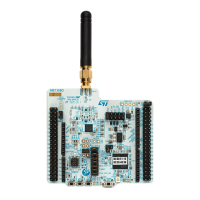Serial peripheral interface / integrated interchip sound (SPI/I2S) RM0453
1282/1450 RM0453 Rev 5
The I2S shares three common pins with the SPI:
• SD: Serial Data (mapped on the MOSI pin) to transmit or receive the two time-
multiplexed data channels (in half-duplex mode only).
• WS: Word Select (mapped on the NSS pin) is the data control signal output in master
mode and input in slave mode.
• CK: Serial Clock (mapped on the SCK pin) is the serial clock output in master mode
and serial clock input in slave mode.
An additional pin can be used when a master clock output is needed for some external
audio devices:
• MCK: Master Clock (mapped separately) is used, when the I2S is configured in master
mode (and when the MCKOE bit in the SPIx_I2SPR register is set), to output this
additional clock generated at a preconfigured frequency rate equal to 256 × f
S
for all
I2S modes, and to 128 x f
S
for all PCM modes, where f
S
is the audio sampling
frequency.
The I2S uses its own clock generator to produce the communication clock when it is set in
master mode. This clock generator is also the source of the master clock output. Two
additional registers are available in I
2
S mode. One is linked to the clock generator
configuration SPIx_I2SPR and the other one is a generic I2S configuration register
SPIx_I2SCFGR (audio standard, slave/master mode, data format, packet frame, clock
polarity, etc.).
The SPIx_CR1 register and all CRC registers are not used in the I
2
S mode. Likewise, the
SSOE bit in the SPIx_CR2 register and the MODF and CRCERR bits in the SPIx_SR are
not used.
The I2S uses the same SPI register for data transfer (SPIx_DR) in 16-bit wide mode.
37.7.2 Supported audio protocols
The three-line bus has to handle only audio data generally time-multiplexed on two
channels: the right channel and the left channel. However there is only one 16-bit register
for transmission or reception. So, it is up to the software to write into the data register the
appropriate value corresponding to each channel side, or to read the data from the data
register and to identify the corresponding channel by checking the CHSIDE bit in the
SPIx_SR register. Channel left is always sent first followed by the channel right (CHSIDE
has no meaning for the PCM protocol).
Four data and packet frames are available. Data may be sent with a format of:
• 16-bit data packed in a 16-bit frame
• 16-bit data packed in a 32-bit frame
• 24-bit data packed in a 32-bit frame
• 32-bit data packed in a 32-bit frame
When using 16-bit data extended on 32-bit packet, the first 16 bits (MSB) are the significant
bits, the 16-bit LSB is forced to 0 without any need for software action or DMA request (only
one read/write operation).
The 24-bit and 32-bit data frames need two CPU read or write operations to/from the
SPIx_DR register or two DMA operations if the DMA is preferred for the application. For 24-
bit data frame specifically, the 8 non-significant bits are extended to 32 bits with 0-bits (by
hardware).

